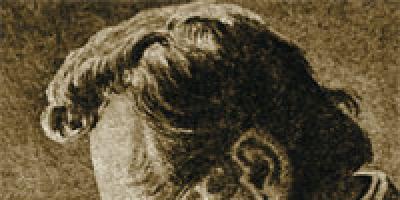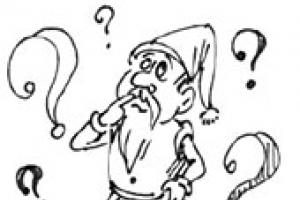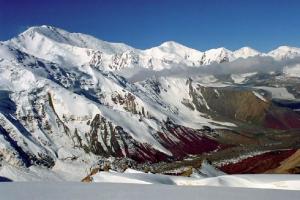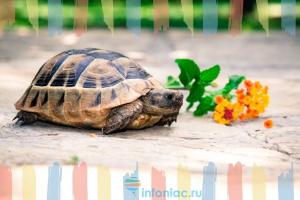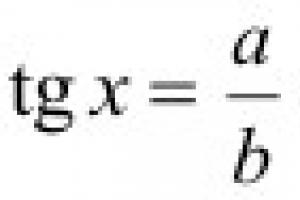Sevinch Mamedova
Summary of GCD in middle group on the topic “Wintering birds”
Educational area: cognitive development
Integration of educational areas: physical development, speech development
Target: expanding knowledge and understanding about wintering birds and the role of humans in their lives.
Tasks:
Educational
to form preschoolers’ knowledge about wintering birds of their native land; Show children how to properly feed birds.
Developmental
enrich children’s vocabulary with new concepts on the topic “wintering birds” and expand children’s knowledge about the life of birds in winter; activate the phrase “wintering birds” in your speech; the ability to speak “loudly - quietly”, develop vocal strength; replenish the active vocabulary on the topic with words: food, feeding trough, cold, hungry; enter a description of winter into the passive dictionary: blizzard, severe, frosty.
Educational
to cultivate a caring attitude towards birds in winter, to create a desire to help the birds of their native land survive in winter.
Demonstration material: pictures of birds from their native land, pictures of bird food for comparison in the warm and cold seasons, a feeder, bags with samples of bird food.
Equipment: mp3 player, audio disc with a recording of bird voices, a musical excerpt from the work of P. I. Tchaikovsky “Waltz of Snow Flakes”, the song “Bird” (words by Yu. Entin, music by D. Tukhmanov) on a flash drive.
Preliminary work: organizing observations of birds flying to the site (crow, pigeon, tit, sparrow, bullfinch); p/i “Sparrow”, “Bullfinches”, “Sparrow”; carrying out finger gymnastics"Feeder"; examination plot paintings on the topic, albums with images of wintering birds; guessing riddles about birds; conversations about wintering birds of our native land; d/i “Flies away - does not fly away”, “Find out by description”.
Methodical techniques:
gaming (use of surprise moments);
visual (use of illustration, presentation);
verbal (reminder, instructions, questions, individual answers from children);
encouragement;
lesson analysis, reflection.
Logics educational activities:
Motivational-reflexive part:
(greeting children in a circle)
My dear friends, quickly run into the circle
And don’t hesitate to take each other’s hands.
You will drive away boredom and laziness -
Give me a smile.
Introductory part:
Educator:
Guys, listen and guess the riddle:
Her snowy embrace
And trees in white dresses.
The weather is frosty.
Who can guess the time of year?
Children's answer: It's winter.
Educator: Winter has come... (The teacher plays an audio recording of the musical work by P. I. Tchaikovsky “Waltz of Snow Flakes”)
The blizzard is sweeping,
And the snow spreads across the ground,
The blizzard sings a song to us,
And it evokes thoughts...
It became frosty and cold outside. Not only animals, but also birds felt the approaching frost. Some of them flew to warmer climes. What are these birds called?
Children's answer: Migratory.
Educator: That's right, these birds fly from one end to another. They are looking for somewhere warmer. But today I will tell you about completely different birds; we will get acquainted with birds that do not fly away anywhere with the arrival of winter. They stay and live next to us. Such birds are called wintering birds.
Main part:
Educator: What kind of birds are these, do you want to know? I will help you find them out by solving the riddles:
This little bird
Lives together as a friend
Picks up crumbs quickly
“Chick-chirk” she sings.
Children's answer: This is the Sparrow bird. (After the correct answer, the teacher hangs a picture depicting the named bird on the magnetic board)
Educator: Sparrow is a small bird with a brown back and gray breast. Sparrows live in a flock. Sparrows are very useful birds. In summer they save us from harmful insects: butterflies, caterpillars, beetles. But in winter time they have been hungry for years. They fly to people's homes in search of bread crumbs, seeds, and grain. (The teacher turns on an audio recording of the sounds of a sparrow).
And here is the next bird, and I have a riddle about it:
Though smaller than a sparrow,
I'm not afraid of frost,
The bird you all know.
And my name is.
Children's answer: Titmouse. (The teacher hangs a picture depicting the named bird on the magnetic board)
Educator: You guys and I see this bird on the street every day. Tits are very active and dexterous birds. Their head, neck, stripe along the chest are black, the wings and tail are bluish, the back is yellow-green, the belly is yellow, and the cheeks and spot on the back of the head are white. Like sparrows, tits feed on insects in summer. And in winter they gather in small flocks and look for food near people’s houses. Tits love lard, seeds, and bread crumbs. (The teacher turns on an audio recording of tit sounds)
And these birds have a secret, I’ll reveal it to you if you guess the riddle:
What kind of birds have arrived?
They sat down on the rowan tree together.
You can see them from afar
Scarlet breast, sides.
Oh, how beautiful the birds are
These are ours.
Children's answer: Bullfinches. (The teacher hangs a picture of a bird on the magnetic board)
Educator: Bullfinches are very beautiful birds, but they live with us only in winter; you won’t see them in summer. Try to describe their appearance: the color of the head, chest and wings.
Children's answer: The head is black, the breast is red, the wings are gray.
Educator: Well done. In summer, bullfinches eat berries, buds, and seeds. But they don’t eat insects! In summer, bullfinches live in flocks in the forest. But in the harsh cold winter, they also fly to people’s homes to feast on seeds and nuts. (The teacher turns on an audio recording of bullfinch sounds)
Without our help, these birds will not be able to survive the winter. I suggest you guys help the birds and prepare a tasty and healthy treat for them.
D/u “Feed the birds in winter”
The teacher brings a feeder into the group and lays out food options for birds on the table: candy, sunflower seeds, millet, wheat bread, chocolate, potatoes, carrots.
Educator: Guys, what kind of food do you think the birds will accept with pleasure and will be very grateful, please help me choose it for the birds. (Children choose plates with the desired food, together check the correctness of the choice and pour the food into the feeder)
Educator:
We made a feeder
We opened a canteen.
Sparrow, bullfinch neighbor,
There will be lunch for you in winter.
Visit on the first day of the week
The titmice flew to us.
And on Tuesday, look,
The bullfinches have arrived.
(Z. Aleksandrova “New dining room”)
Educator: You did a good job! During the walk, we will hang the feeder on a tree branch on the site and watch the birds, and see who will fly to the bird canteen on the street. And now I invite you to play, the game is called “Birds for a Walk.”
Outdoor game “Birds on a walk”
The teacher lays out circles on the floor large diameter grey, yellow and red colors. The gray circle will determine the feeder for sparrows, the yellow one for tits, the red one for bullfinches. The teacher verbally tells each child the name of the bird. An audio recording of the song “Bird” is turned on. Children, pretending to be birds, move around the group. At the command “The dining room is open!” the birds flock to the appropriate feeder. The teacher and children determine the fastest and most friendly flock of birds.
Final part:
Educator: I invite everyone to our circle to remember what we talked about today. (Children prepare for reflection, sit on the carpet in a circle and join hands)
Children's answer: We talked about birds in winter.
Educator: Lera, what birds are called migratory?
Child's answer.
Educator: Kolya, what kind of birds are called wintering ones? Why?
Child's answer.
Educator: Kirill, please name the wintering birds that you remember.
Child's answer.
Educator: Guys, what do sparrows eat in winter? What about in the summer? Guys, what do bullfinches eat in winter? The same goes for tits. (Children answer the question based on the pictures on the magnetic board)
Educator: Kira, what did you learn interesting in class? What surprised you?
Child's answer.
Educator: But we haven’t done everything with you yet, we still have a very important task left. I suggest we go outside and hang a bird feeder in our group’s area.
Open educational activities to familiarize yourself with the outside world in the middle group “Our feathered friends”
Objectives of the priority educational area.Environmental education with elements of speech development.
Objectives of OO in integration.
Cognitive development:
Teach children to distinguish and name wintering birds; introduce characteristic features appearance, behavior, lifestyle of wintering birds.
Speech development:
Learn to understand the content of poems and songs, repeat words after the teacher, sing along with phrases in a song; promote the activation of speech, teach how to pronounce onomatopoeic words, and answer the teacher’s questions.
Artistic and aesthetic development:
Develop dancing abilities and ear for music; develop the ability to perform movements to the rhythm of music accompanied by artistic words.
Continue to learn how to pinch off small lumps of plasticine and carefully place finished goods on the board.
Physical Culture:
Improve children's motor skills and abilities; develop speed, dexterity, interest in outdoor games; learn to run freely without bumping into each other, respond to verbal signals from the teacher, and return to their place.
Progress of educational activities.
Introduction.
- Look at the tree in our group. It's cold outside. And then a bird flew in to bask in our tree. (Showing “Magpie – white-sided” bird model)
- What is this bird called?
- Who knows a nursery rhyme about a white-sided magpie?
Finger game.
White-sided magpie, where was it?
Far!
I lit the stove, cooked porridge,
She jumped on the threshold and called guests.
The guests arrived and sat down on the porch.
Gave this one (4 times).
But she didn’t give it to this:
He didn’t walk on water, he didn’t chop wood,
I didn’t light the stove, I didn’t cook the porridge.
Physical education minute.
Another bird flew to us (showing a model of the Bullfinch bird).
A bullfinch flew to us.
The bullfinch sat on a branch,
The rain splashed and he got wet.
The breeze, blow lightly,
Discuss it for us, little bullfinch.
A sparrow flew to us and sang a song cheerfully (a model of the bird is hung on a tree branch).
A sparrow jumps and spins around the puddle.
He ruffled his feather and fluffed out his tail.
The weather is good!.Chiv! Chiv! Chiv!
Mystery. Listening to the voices (singing) of birds.
Another tit bird flew to us (a model of the bird is hung on a tree branch).
Guess! What bird?
Lively, perky, dexterous, agile.
The shadow rings loudly: Shadow! Shadow!"
What a nice frosty day.
- Children, let's listen to them sing.
5. Onomatopoeia of bird voices.
- The crows flew to us, and let's scream!
- How do crows scream? (Children - “Kar! Kar!”)
Consolidation.
Finger play (Finger flank massage)
Let's see who came to us.
So-ro-ka - little finger
Vo-ro-bey - nameless.
Si-ni-tsa - average.
Vo-ro-na - index.
Bird - big
And snow-gi-rik - clap your hands!
Outdoor game "Birds in the Nest".
Goal: to teach children to run freely without bumping into each other, to respond to verbal signals from the teacher, and to return to their place.
Birds jump, fly, birds sing merrily.
Birds collect crumbs, birds peck grains.
The feathers were cleaned, the beaks were cleaned,
Then they flew and sat down.
Finger game: “What do birds eat?”
- Our birds are cold, there is no food outside. What do our birds like to eat? Now we will find out: (alternately connect all fingers with the thumb)
The bird is also looking in the grass,
Both on the branches and in the foliage, (change of hands)
And among the big meadows
Flies, worms, grain, beetles.
Modeling “Grains for Birds”.
Goal: Continue to learn how to pinch off small lumps of plasticine and carefully place the finished products on a board.
- Come on, now we’ll make some grains for the birds and feed them.
Bottom line.
- Now we’ll feed our birds. Well done, our guys, they all made grains. We fed the birds.
- And there are still a lot of hungry birds on the street. My parents and I made feeders at home. When we go for a walk, we will hang up feeders and give the birds real grains.
We continue to watch birds on our walk. Together with the teacher we feed the birds. OD on “Artistic and Aesthetic Development” in the middle group. Drawing "Polar Bear" using
(Children guess riddles and show the birds on the poster)
Educator: Guys, what can you call these birds in one word?
Wintering.
Educator: That's right. And then tell me, what is the name of our city, where you and I live?
— Okhotsk.
- What do you think, do we have these birds in Okhotsk? (Yes)
Educator: Okay, well done! I agree with you. You know, guys, it’s very difficult for birds in winter, there are severe frosts and it’s difficult for birds to find food.
Now I want to tell you one history. Do you want to listen? (Yes)
In winter, Masha and Vitya walked in the park. In the snow, the guys saw a freezing sparrow. Masha took the bird in her hands and began to warm him with her breath. The guys decided to save the sparrow. They put the bird in their mitten and hurried home. At home, the sparrow warmed up and began pecking at the seeds. In the evening, Vitya made a feeder. The next day, the guys released the sparrow into the wild, and hung a bird feeder on a birch tree in the park. Every day the children brought bread crumbs and seeds to the feeder. This is how the guys helped the birds survive the harsh winter.
— Did you like the story? (Yes)
— What were the names of the girl and boy? (Masha and Vitya)
Who did they find? (sparrow)
— how did they help the sparrow? (put it in a mitten and took it home)
- What did Vitya do? (feeder)
Why do birds need a feeder? (for the birds to eat)
— Tell me, what is actually most terrible for birds is hunger or cold? (hunger)
Of course, guys, hunger is terrible, because birds are warmed by feathers, and under the snow it is difficult for birds to find food.
- Do you think the guys did a good deed? (Yes)
Educator: Would you like me to read the story to you again? (Yes)
(Takes a piece of paper) But the trouble is, I put the piece of paper on the table, and there was water here and some of the words turned out to be blurry, but I really wanted to read the story to you again, maybe you can help me, and we can read it together? (Yes)
(The teacher reads and the children complete)
Educator: Well done, thank you guys, maybe someone wants to retell our story? (children retell)
Educator: Thank you, guys. It's so cold outside, even our hands are frozen. Let's warm them up. (self-massage of hands is performed)
Once. Two. Three. Four. Five (curls fingers)
We went for a walk in the yard (walk fingers over palm)
They sculpted a snow woman (roll the lump with two palms)
The birds were fed crumbs (crumb the bread)
Then we rode down the hill (run a finger across the palm)
And they were also lying in the snow (put palm on top of one palm,then the other side)
Everyone came home covered in snow (we shake off our palms)
We ate soup and went to bed (movement of an imaginary spoon, hands under the cheek) 2 times
Educator: While we were playing, it snowed heavily and real snowflakes flew to us. Look what they are?
Do you want the snowflakes to spin? (Yes)
- Then you need to blow on them (slowly draw air through your nose. Don’t puff out your cheeks, stretch your lips like a “tube” and blow on the snowflakes.
(children perform exercise "Snowflakes" 3-5 times)
Educator: And now I propose to play again. The game is called: “Pass the snowball – say words of action”
In winter, the weather outside can be different: sometimes it’s a snowstorm, sometimes it’s severely frosty, sometimes it’s snowing. I will ask you questions, and you answer.
- Frost (what does it do?) - freezes, pinches, bites
Blizzard (what is it doing?) – howls, rages, sweeps
- Snow (what does it do?) - goes, circles, flies, falls
Children (what are they doing?) - playing, riding, rejoicing, having fun
— The sun (what is it doing?) – shines, but does not warm
Educator: Well done guys, you completed the task. Now come to me and look at our diagram. Let's we honor those already familiar to us poems in various ways.
(Children look at the diagram and explain how to read - loudly, quietly, quickly, slowly, cheerfully, sadly)
Children play and read poems in pairs:
The bear got very sick, the bear ate a lot of honey
The bear cries and growls. My stomach hurts.
Educator: I really liked how you read the poems correctly according to the scheme. And I’ve also prepared a picture for you about winter (after all, it’s winter here now). Your task, guys, is to place the animals correctly where they should live.
Children: - This is a wolf, he lives in the forest.
- This is a bear, he lives in the forest.
- This is a cat, she lives with a person.
- This is a dog, she lives with a person and... etc.
Educator: Guys, while we were studying, our snowflakes that flew to us melted, because it’s warm in our group (and the snow, remember our experiments, melts in the warmth), I suggest you draw the snowflakes yourself, take markers and draw.
Children draw on their own while listening to music.

Lesson summary for the middle group
"Wintering Birds"
Program content:
- Give children an idea of the types of food of wintering birds.
- Reinforce the concept of “wintering birds”
- Develop imagination, attention, thinking, holistic perception of objects.
- Activate generalizing words in speech: “wild animals”, “wintering birds”; enrich lexicon by introducing the words: food, feeding trough, cold, hungry; enter a description of winter into the passive dictionary: blizzard, severe, frosty.
- Cultivate a caring and friendly attitude towards birds.
Demo material: illustrations depicting a hare, squirrel, fox, wolf, sparrow, crow, bullfinch, tit; models with food types of “wintering birds”; envelope; millet, a piece of lard, rowan berries, sweets, sunflower seeds.
Handout:half a sheet of paper with models of food types; images of birds - sparrow, crow, bullfinch, tit, cut into pieces (head, body, tail).
Equipment: tape recorder, audio recording with bird voices, tree models, magnetic board, cap with a picture of a magpie.
Progress of the lesson.
The children enter the group into a group, at this time Magpie flies in and cracks:
Magpie: I was in the forest today, some birds flew away, others remained, I don’t understand anything, what’s what?
Educator: Hush, hush, don't make noise. Guys, did you find out who it is?
Children: Magpie.
Magpie : Oh, hello, guys!
Children : Hello, Soroka!
Educator : What happened, Magpie?
Magpie : So I say, I was in the forest today, some birds flew away, others remained, I don’t understand anything.
Educator: Let's go into the forest together and help Soroka figure it out.
Children: Let's go!
Educator: One, two, three, turn around and find yourself at the edge of the forest!
The children turn around and find themselves at the edge of the forest. The voices of birds are heard.
Educator: Look, guys, how beautiful it is around, what an air! Do you hear voices? The forest dwellers are greeting us. Who is it that greets us and greets us so affectionately?
There are pictures of animals and birds on the table. Children call them.
Educator: Well done, right. How can you call a squirrel, a wolf, a hare and a fox in one word?
Children : Wild animals.
Educator : How can you call a sparrow, tit, bullfinch, crow in one word?
Children: Wintering birds.
Educator : Place animals on one side and birds on the other. Well done boys! Do you like to solve riddles? Guess what kind of bird this is.
Someone is jumping along the path,
It pecks at seeds and crumbs.
“It’s not scary here, don’t be shy!” -
He shouted to a friend... (sparrow).
Who's looking at the sidewalk
And shouts to us from a branch: “Karr!”?
Crumble a piece of loaf -
Will fly in to eat...(crow).
They arrived in a booming flock
Birds with a bright red breast.
Look outside the window -
There on the branches... (bullfinches)
Who shows off on the branch
In a yellow holiday vest?
This is a little bird
And her name is... (titmouse)
Children find the hidden birds and attach them to the board.
Educator: What kind of birds are these?
Children: Wintering.
Educator : Why are they called that?
Children : Because they stay for the winter.
Educator: Guys, do you remember what winter it was like? Severe, blizzard, frosty. Is it easy for birds in the forest in winter? Why?
The children are thinking.
Educator: Yes, that's right, guys. It is difficult for birds to find food under the snow. They fly closer to people for help. Adults make bird feeders and pour food into them. Would you like me to tell you which bird eats what?
Sparrows feed on crumbs and grains. Let's agree to label them (puts out a card with a model on the board).
Tits feed on grains and crumbs; their favorite delicacy is lard, which we will designate (model).
Bullfinches eat plant seeds and love to peck rowan berries; we will designate them (model).
Crows feed on scraps, leftover food, and love candy; we will designate them (model).
Educator: Let's play now. Magpie, come play with us!
Sedentary game “The birds have flown”
The teacher only names birds, but if he makes a mistake, you can stomp or clap your hands.
Educator: Birds arrived: pigeons, tits, flies and swifts.
The children are stomping.
Educator: What is wrong?
Children: Flies.
Educator: And who are the flies?
Children: Insects.
Educator: Birds arrived: pigeons, tits, storks, crows, jackdaws, macaroni.
The children are stomping.
Educator: Birds arrived: pigeons, martens.
The children are stomping.
Educator: The birds have arrived:
Pigeons, tits,
Jackdaws and swifts,
Lapwings, siskins,
Storks, cuckoos,
Even owls are scops owls,
Swans, starlings.
Well done to all of you!
Magpie: Oh, while you were playing here, I found something under the tree!
Magpie brings an envelope.
Magpie: I don’t understand who this is?
Educator: Don’t fuss, Soroka, the guys and I will now figure out who owns the head, who the torso, who the tail. If you add up the parts of a bird, you get a whole bird. Guys, let's collect the birds.
Children put together bird parts.
Magpie: Now I recognize birds. How cleverly you do it.
Educator: Let's put the birds on the feeders.
Children attach a piece of paper with food models to the birds.
Educator: You've fed the birds, let's give Magpie a treat, it's not easy for her in winter either.
Children treat Soroka with sunflower seeds.
Magpie : Thanks guys for the treat. Now I’ll tell everyone why not all the birds flew away and what they eat. Goodbye, guys!
The children say goodbye to Soroka.
Educator: Well, guys, it’s time for us to return to kindergarten. One, two, three, turn around and go back to kindergarten!
Result: - What birds did you meet in the forest?
How can you call them in one word?
You and I will now go for a walk and feed the birds.
- Who should we treat with lard?
- Grains?
- Rowan?
- Sweets, seeds?
Lesson notes for the middle group “Wintering Birds.”
Author
Integrated educational areas: “Cognition”, “Communication”, “Socialization”, “Labor”.
Activities : communicative, cognitive, productive, gaming, labor.
Software tasks:
Educational: Expand the concepts of “wintering birds”, “migratory birds”;
Expand knowledge about the role of birds in nature and human life;
Introduce children to wintering birds: tits, magpies, sparrows and bullfinches, crows - folk signs associated with the habits of birds.
Learn to sculpt a bird in a constructive way, observing the location and relationship of body parts, connect the parts, pressing them against each other;
Developmental: Develop thinking and observation skills;
Development of visual and verbal-logical memory;
Contribute to the enrichment and deepening of ideas about birds (habitat, needs and ways to satisfy them)
To promote the development in children of the ability to write stories about birds, highlighting bright features their appearance.
Educational: Cultivate an interest in the life of birds, a caring and friendly attitude towards birds, and a desire to help them survive the harsh winter season.
Vocabulary work: Food, feeding trough, cold, hungry, blizzard, harsh, frosty;
Material and equipment: Illustrations depicting birds - tit, sparrow, bullfinch, crow, magpie; illustration of winter pictures; cut-out pictures of birds; plasticine; sunflower seed, beads.
Problematic issues: -What do birds eat in winter?
Do birds sing in winter?
Where do birds spend the winter?
Description of the IOS scenario
Q: Children, what time of year is it now?
Q: What changes have occurred in nature, and with animals and birds?
D: The trees are bare and it’s getting colder; animals hibernate, some animals change their fur coat to a warmer one; birds fly south to warmer climes.
Q: What can you say about birds that fly south?
D: Migratory
Q: List migratory birds.
D: Swift, crane, cuckoo, swan, duck.
Q: Which birds leave us the earliest?
D: Birds that feed on insects, they fly away after the first frost, just as insects disappear - wagtails, larks, starlings, and when lakes and rivers freeze, waterfowl (geese, ducks, swans) fly away.
Q: Guys, what time of year comes after autumn (children’s answer). The teacher shows a picture of winter and bird feeders. Teacher questions:
What season?
What kind of winter is it?
What are people doing?
Who did they make the feeders for?
D: For birds.
Q: But they just said that in the fall birds fly away from us to warmer climes. It turns out that not all the birds flew away, but only migratory birds. But many birds do not fly away, but remain to spend the winter in our area. What are the names of the birds that stay with us for the winter?
D: Wintering.
Q: Where do wintering birds live?
D: In the forest (high in the trees, in nests and hollows) and in the village.
Q: Yes, everything is correct, children. We will talk about wintering birds, but what wintering birds do you know? (children's answers) Well done.
Listen to riddles about birds.
1. The back is greenish,
The belly is yellowish,
Little black cap
And a strip of scarf. (Tit)
2. In winter there are apples on the branches!
Collect them quickly!
And suddenly the apples flew up,
After all, this is. (Bullfinches)
3. Small bird
In a gray army jacket
Snooping around the yards
Collects crumbs. (Sparrow)
4. Color - grayish,
Habit - thieving,
Hoarse screamer -
Famous person.
Who is she?. (crow)
5. Who flies, who chirps?
Want to tell everyone the news? (Magpie)
Well done, right. Now let's play, choose a hat with a picture of a bird, imagine that you are a bird, I will read a poem, the bird that hears about itself “flies” to the “feeder”.
We made a feeder
We opened a canteen.
Visit on the first day of the week
The tits have flown to us,
And on Tuesday, look,
The bullfinches have arrived.
There were three crows on Wednesday
We didn’t expect them by lunchtime, but on Thursday from all over
A flock of yellow tits.
On Friday in our dining room
The pigeon enjoyed porridge
And on Saturday and Sunday there was general fun.
Q: Guys, is it easy for wintering birds in winter? Why? (children's answers)
D: No, it’s not easy for them to be cold and hungry.
Q: That’s right, they have a very hard time in winter and there is little food and cold in winter. Who comes to their aid? (children's answers) What happens if all the birds die from cold and hunger?
D: Birds will die - there will be no one to destroy harmful insects, trees, bushes, grasses will get sick and die. The animals will have nothing to eat and will leave the forest. Man cannot live without birds, without animals, without forests. Therefore, birds must be protected and helped. They bring great benefits.
Q: Well done guys, everything is correct. And now we will play the game “Collect and tell about the bird.”
To do this, we will divide you into five subgroups, I will give each of the subgroups an envelope with parts of the picture, you must put the parts together into a whole picture and tell who or what is depicted in it.
The first subgroup of children puts together a picture with an image.
D: This is a tit bird. The tit's chest is yellow, and in the middle there is a black tie, a black cap on its head, etc. The tit makes the sounds: blue-blue-blue. Tits bring great benefits to forests, parks and gardens.
Q: How much and interestingly you told me, and I recently read in a book that the tit, and specifically the males, are among the first to sing in the spring, so they say that the song of the tit brings spring with it. Folk sign It says that the first mass appearance of tits near houses is a sign of the onset of severe cold weather. The titmouse starts squeaking in the morning - expect frost.
The second subgroup of children collects an image of a sparrow.
D: This is a sparrow bird.
Q: What can you tell about him?
D: He has gray-brown plumage, a short tail, thin legs, he is small but nimble. They sit on hedges and branches of bushes and cheerfully chirp: “Chick-chirp-chirp-chirp.”
Q: Guys, I know that a sparrow does not change its place of residence during its life, unless need forces it. For example: the nest will be destroyed or some disaster will happen. And all its life the sparrow repairs its nest, insulates it and keeps it clean. There is also a sign that if in winter sparrows sit quietly on trees or buildings, there will be snow without wind. And they chirp together - for warming. Sparrows crawl into hiding places, under roofs or piles of brushwood - towards frost or before a snowstorm.
The third subgroup of children puts together a picture of a bullfinch.
D: This is a bullfinch bird.
Q: Tell us how this bird differs from others?
D: The bullfinch has a red chest, a gray back, a cap on its head, black wings and a tail.
Q: And you know a lot about the bullfinch. And I will share with you interesting facts. The stronger the frost, the calmer the flock sits, occasionally moving to pick a berry, break off a bud, and then sit motionless again for a while. And so on all day. As darkness approaches, the entire flock flies into the bushes or trees, where they spend the night, hidden in the branches. With the onset of spring, bullfinches disappear from the village, but it turns out that they do not fly to the north, but settle in coniferous forests, hatch their chicks there and wait for winter. The sign says that if a bullfinch starts singing, there will be a blizzard. A bullfinch sings under the window in winter - to the thaw.
The fourth subgroup of children.
Q: Let's see what kind of bird they collected.
D: This is a magpie. The magpie has a nickname - white-sided. The feathers on her sides are white, and her head, wings and tail are black, like a raven. The magpie's tail is very beautiful - long, straight, like an arrow. The feathers on it are not just black, but with a beautiful greenish tint.
Q: The magpie cannot be confused with any other bird. Everyone knows her habit of stealing and hiding shiny objects. Magpie usually settles in open place with many trees and bushes. She avoids the dense forest. The legend says that when a magpie climbs under the eaves (roof), it means there is a blizzard.
Q: Let's see who our fifth subgroup has gathered.
D: This is a crow. Based on their color, there are two groups of crows: gray and black. The hooded crow has a black head, neck, tail, beak and legs, and everything else is grey. The Carrion Crow is all black with a metallic blue and purple sheen. For nesting, crows choose the edges of forests and copses among fields and meadows. They also settle in large numbers in the centers of large cities, which is especially typical for the gray crow. People say that if crows fly and circle in flocks in winter, it means frost. If crows dance in the sky, there will be snowfall.
Well done, smart guys, everyone coped with this game. And now we will play another very interesting game “Sparrows and the Cat”.
"Sparrows and the cat."
Children stand on a bench or on chairs on one side of the playground - this is the roof of the house. A cat - a teacher or one of the adult children - is sitting nearby. The cat falls asleep. “The sparrows are flying in,” the teacher commands. Sparrows jump from the roof and scatter in different directions. But then the cat woke up. He shouts: “Meow-meow,” and runs around catching the sparrows who are trying to hide on the roof. Everyone who is caught by the cat is taken to their home.
These agile birds, without fear, jump near a person’s feet and pick up crumbs under the very nose of a well-fed cat.
Guys, do you know what birds eat in winter? (children's answers)
1. The tit feeds on sunflower and pumpkin seeds, will not refuse buckwheat grains, and loves unsalted lard. She lives in parks and gardens. For the winter, these birds do not fly to warm countries, but in search of food, flocks fly from place to place. Where there is a lot of food, tits linger. By feeding, you can keep them in your garden.
2. The sparrow feeds on bread crumbs, berries, and sunflower seeds.
3. With its thick beak, it chews berry seeds or small nuts. The bullfinch feeds on buds and seeds of trees and shrubs, berries, from which it selects the seeds and throws away the pulp. After tasting the rowan, the bullfinch cleans its beak: rowan seeds stick to it. When cleaning the beak, they fall to the ground and germinate in the spring.
4. Magpie and crow are omnivores. In winter it feeds on the remains of human cuisine. They love cereal grains, sunflowers, watermelon, melons, seeds various plants, insect pests and small rodents.
Well done guys, everything is correct. Here we received a parcel with a letter from wintering birds. Are you wondering what's in the bag? Now you will try to guess what is in them. I suggest you play the game “Wonderful Bag” and determine by touch what is hidden in them.
Children identify bird food by touch. (The bag contains: sunflower seeds, pumpkin seeds, millet, bread, plant seeds).
Q: Well done guys, you already know what kind of bird it eats, look at the picture guys and tell me what you see. (Children's answers)
Q: What is the feeder for? (Children's answers) That's right, now we will put the food in the feeder for our birds.
Where are our birds? Guys, what can you make birds out of? (Children's answers). I wonder, is it possible to make birds? Come on, we blind the birds and put them in our feeder. Imagine a bird that you would like to make. First, take a piece of plasticine of the color of the bird you will sculpt.
Then divide the lump into three pieces (one large and two smaller). From big piece we sculpt the body in the shape of an egg, pull the tail back (flat it with our fingers).
We have two identical pieces left. From one we will make a head (we roll a ball between our palms, from the second we will make wings (we flatten a piece of plasticine in the shape of a circle and cut it in half in a stack). We connect the parts. We make the head (we make a beak from a seed, eyes from beads).
Well done guys, everyone turned out great birds. Today, when we go for a walk, we will take bird food with us (I’ll ask the people on duty at the nature area to take bird food) and feed the birds that fly to the feeders.
Lesson summary:
Q: Guys, who did we talk about today?
D: About wintering birds, about how difficult it is for birds in winter, and that one must treat birds with care and kindness and the desire to help them.
         
|
Read 717 once

Date of birth: 03/06/1978
Education: higher, ASU 2002
Specialty: “Pedagogy and methodology of primary education”
Place of work: “Kindergarten No. 12”
Work experience: 15 years
My motto: "If you want to be heard by a child, know how to love first, then teach..."
My pedagogical credo: “Every year we should meet and see off, and every day look into children’s souls. Every hour we should feel unity with them, and become purer, better.”
Business card
That's how nature works
From year to year, from century to century.
Every minute in the world
A new person enters the world.
And like a sprout, emerging in the spring,
He experiences this world for the first time.
It grows and develops, it breathes,
And appreciates every moment in this life!
Dear colleagues! Hello dear jury.
I, Shetova Rita Askarbievna, teacher kindergarten No. 12 “Dzhenet” A. Khodz, graduated from the Adygea Pedagogical College named after Kh.B. Andrukhaev in 1997, Adygea State University graduated in 2002.
“A new day comes, I rush to work and think about my students, about meeting their parents, about upcoming events. I'm a teacher. I have been working with small preschool children for 16 years and have never once had the desire to change my profession. After all, to some extent, we, preschool teachers, are also the creators of children's souls. After all, the seed of kindness that we sow will certainly grow in the future. How pleasant and honorable it is to be a creator!
The most important reward for me as a teacher is the love and recognition of the students, their parents and my colleagues. My task is to take care of the health and life of the child. To create conditions under which every child has the opportunity to develop, learn, create, make friends, take care of our little brothers and, of course, each other. In my work I use health-saving, gaming technologies, and design technologies.
Over the years of my work, I have developed my own view of the profession
Educate a child, developing his personality.
Be able to notice a child’s success in time and help him open up.
Give a child a piece of your soul.
To become as dear and dear to your pupils as a mother, children should be in a world of love, understanding and so that they are confident that they will be helped
In the diagnostic process, I use methods of observation, games, and conversations that are accessible to the children’s age.
In the group, I created a subject-specific development environment in which each child has the opportunity to penetrate the circle of social relationships and model them in his own way.
One of the leading areas of my work is interaction with parents. The use of modern pedagogical technologies and cooperation with the family allows me to intensify relationships based on mutual understanding and trust. Parents are my most important helpers in working with children.
Today I am concerned about the problem of preserving and strengthening the health of children. Therefore, in my work I use health-saving technologies that help children develop a correct, careful attitude towards their health and the environment.
In the process of direct educational activities, I use modern educational technologies:
Gaming technologies (creating game situations)
Research method of teaching (experimenting with paint colors)
Information and communication technologies (I use multimedia presentations).
Our profession is so “alive” that it does not allow us to stand still, but requires us to constantly be aware of all events, from global events to children’s problems. There were moments when another pedagogical success or the success of children gave me strength and I wanted to work even more actively.
I am a happy man. I love my job, I realize its importance and necessity. People trusted me with the most precious thing they have - their children.
How a child will grow up, whether he will become a kind, sympathetic person, a creative person, this depends on everyday work.
What can I give to children? First of all - love. And I love them the way they are. An educator is a teacher, that is, a person who teaches, helps to learn the world. And how effective this process will be depends on the interest of my little students. And so, day after day, we walk together along the path of knowledge, along which they learn to distinguish between good and evil, get to know themselves and the world around them, and I constantly learn from them devotion, openness and love. Children are our future!”
Of all professions
I chose one.
What could be more beautiful in the world,
What to vaccinate children with
Love for good
And be responsible for them
A. Dementyev

